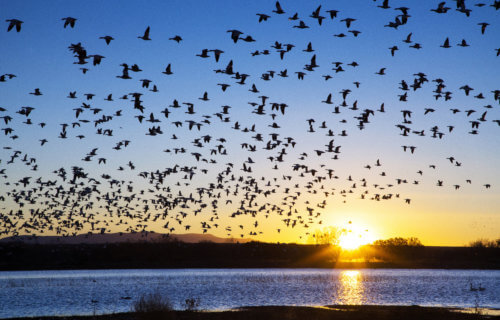GAINESVILLE, Fla. — Is it better to stand out from the crowd or blend into the background? For birds, the answer is complicated. While peacocks flaunt their brightly colored feathers to attract mates and ward off predators, other birds find it advantageous to conceal themselves by mimicking the looks of other birds.
Groups of birds flying together often come from the same species, making it hard to distinguish one from another. However, some flocks of birds including two or more species take on similar appearances, which is an uncommon phenomenon. This prompted Florida researchers to understand why.
“They all share haphazard traits, like crests or yellow bellies, which makes them almost identical. You can’t really tell them apart without looking at their markings,” says Scott Robinson, an Ordway eminent scholar at the Florida Museum of Natural History and study co-author.
His new study suggests mimicking another bird’s appearance is not a coincidence but rather an evolutionary tactic to increase their chances of survival. Looking like a bird from a dominant species helps reduce aggression from other members and appear more threatening to potential predators. In one case, mimicry fooled predators into thinking a flock of birds was poisonous.
“In mimicry, you often want to look like something because there’s an advantage to being that other thing. You want species to think you’re toxic or low-profitable prey,” says Rebecca Kimball, a professor of biology at the University of Florida, in a media release. “In flocking birds, one idea is that this has more to do with a predator’s ability to isolate a target. When there are a bunch of birds moving around, it may be easier for predators to identify an individual that has a distinct color pattern.”
Birds of other feathers also flock together
The idea of safety in numbers among unrelated birds was first brought up in the 1960s while scientists were studying flocks of birds in the Andes Mountains. However, follow-up studies failed to show definitive evidence of mimicry among the multiple species. The theory was quickly abandoned, though it did not leave the mind of some bird researchers.
“The idea sat fallow for a long time,” Robinson says.
In 2010, he began working with a Chinese colleague in Yunnan province and observed the same phenomenon first described decades earlier. Robinson and his colleagues then spent several years studying similarities in China’s multispecies flocks finding the same patterns among them.

The similarities ranged from subtle to visually noticeable. For example, the Himalayan cutias have a wacky appearance. They are dressed head to toe in mismatched layers with a mask of black features, chestnut wings, and a white chest filled with zebra-looking stripes. Their unique appearance makes them stand out but the rufous-backed sibias do a good impression of it. Excluding the stripes, both species have similar behavior, foraging patterns, and markings.
Some birds are capable of mimicking multiple species as they grow up. Young white-hooded babblers have rusty head feathers, brown wings, and creamy underbellies that resemble their traveling buddies, the parrotbills. Once adults, their looks morph into a twin version of the white-crested laughingthrushes with their white heads and dark brown wings.
Imitation leads to more biodiversity
While it may not seem like it at first, mimicking other birds is helping to create more diverse species. Not only do birds imitate more than one species as they grow up, but their appearance varies over time. Since they don’t look like an exact replica of the other bird species, Robinson says you may get one species becoming two.
“The possible role this type of mimicry plays in speciation is the most interesting idea from our point of view. Many of these birds have huge ranges, and there may be a lot of differentiation in these traits involved in flocking within a species.”
How does a bird create this type of mimicry in flocks? First, a flock needs to comprise a few different species, with some more common than others.
“When you have a flock with a really dominant, abundant species, there’s a model worth mimicking. If other birds look like that model, they get the same protection, they get access to the same resources, and they get to travel with a compatible group,” adds Robinson.
The second part is the continued sense of danger from predators. For example, Southeast Asia has 30 percent of all raptor species, which puts pressure on flocks to adapt in some way to avoid getting eaten. This may also explain why mimicry is seen more in areas like China and not worldwide.
The study is published in Philosophical Transactions of the Royal Society of London (B).
You might also be interested in:
- Why are birds disappearing? After 40 years, scientists still don’t have a clear answer
- Birds keep hitting windows – now scientists are learning something from their last poop
- Majority of U.S. birds are rapidly dying off, report warns, though one population is thriving

